Understanding Society - Gender and Work in Scotland: research findings
Analyses data from Understanding Society on mothers returning to work and gender roles and attitudes
Gender Roles and Attitudes
This section focuses on gender roles and attitudes among married fathers and mothers. Responses to two statements on gender roles were collected from married mothers and fathers: "Husband and wife should both contribute to household income" and "The wife should stay at home while the husband earns". In addition, perceptions of which partner is mainly responsible for a number of domestic activities were collected from both spouses. Information was also collected on reported time spent on domestic responsibilities.
Note that the data analysed here only includes married men and women (not civil partnerships or cohabitations), only includes couples with dependent children in the household, and excludes the small proportion of women who were on maternity leave. Employment includes self-employment.
Attitudes to Gender Roles
Responses to questions on gender roles were collected in Waves 2 and 4 of the Main Survey (2010-2012 and 2012-2014). The data is broken down by gender, age, and employment status, although the sample of fathers not in employment was too small to consider separately. The sample size of married parents in Waves 2 and 4 was 1,672, although not all of these answered the questions on gender roles. Ninety-two percent of fathers were in employment, compared to 77% of mothers. Since data is only available from two waves, which are fairly close in time to each other, changes between the two waves may not be indicative of actual trends. This section therefore focuses on the latest available wave (Wave 4, 2012-2014).
Figure 4 (overleaf) shows responses to the statement that "husband and wife should both contribute to household income". Among married parents in employment, mothers were more likely to agree with the statement, with 56% of mothers agreeing compared to 51% of fathers. However, among all married parents – i.e. including those not in employment – fathers were more likely to agree with the statement, with 52% of fathers agreeing versus 49% of mothers. This is because married mothers not in employment, who represented the majority of parents in the sample not in employment, were less than half as likely to agree with the statement as mothers who were in employment (24% versus 56%; not shown).
Figure 4: Responses to statement: "Husband and wife should both contribute to household income"
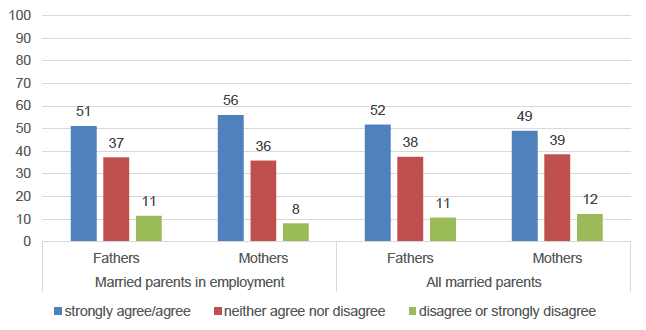
Source: Understanding Society, Wave 4 (2014-2016).
A somewhat inverted pattern was observed for the statement that "the wife should stay at home while the husband earns" (Figure 5, below). Among married parents in employment, fathers were more likely than mothers to agree with the statement, with 8% of fathers agreeing compared to 5% of mothers. Among all married parents, fathers were still more likely to agree than mothers, but the difference was smaller, with 9% of fathers agreeing compared to 7% of mothers. This is because married mothers not in employment were more than three times as likely as married mothers in employment to agree with the statement (18% versus 5%; not shown).
Figure 5: Responses to statement: "Husband and wife should both contribute to household income"
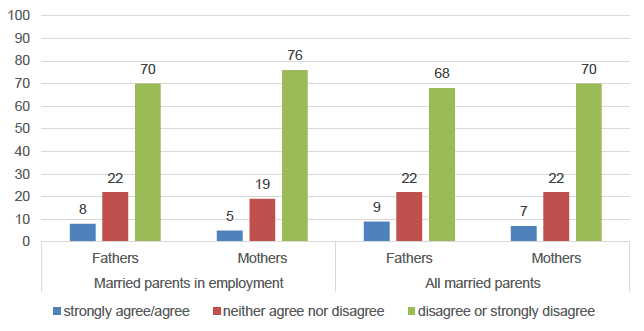
Source: Understanding Society, Wave 4 (2014-2016).
Figures 6 and 7 (below) break these results down by age for all married parents. Younger cohorts were generally no more likely than older cohorts to agree with the statement that "husband and wife should both contribute to household income". On the contrary, younger cohorts were more likely to disagree with the statement, with married mothers younger than 35 particularly likely to disagree (21%). This is reflected in responses to the statement that "the wife should stay at home while the husband earns": the youngest cohorts (<35) were the most likely to agree with the statement, although, in this case, fathers younger than 35 were particularly likely to agree (23%).
Figure 6: Responses to statement: "Husband and wife should both contribute to household income", all married parents
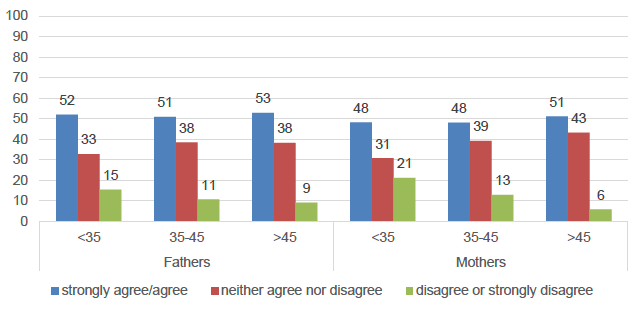
Source: Understanding Society, Wave 4 (2014-2016).
Figure 7: Responses to statement: "Wife should stay at home while husband earns", all married parents
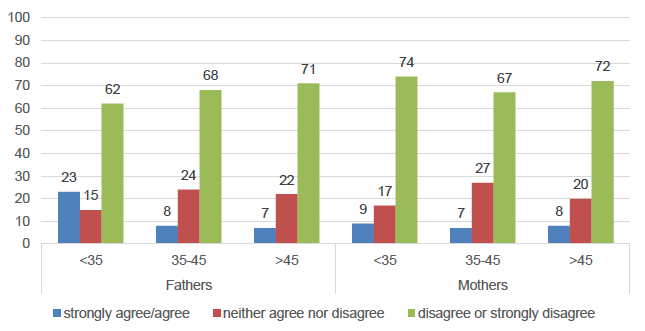
Source: Understanding Society, Wave 4 (2014-2016).
Responsibility for Domestic Activities
Responses on which partner is mainly responsible for domestic activities were collected in Waves 2, 4, 6, and 8 of the Main Survey (2010-2012, 2012-2014, 2014-2016, and 2016-2018). Eight activities were covered in total: grocery shopping, cooking, cleaning, washing, childcare, DIY, gardening, and financial decisions. Responses were also collected on the amount of time per week spent on domestic responsibilities.
The data is broken down by gender and employment status. In total, 1,229 married couples, all of which were different-sex couples, responded to the questions. In 75% of these couples, both parents were in employment, while in 19% the father was in employment but the mother was not. The mother was in employment but the father was not in 3% of couples and in another 3% neither parent was in employment; both of these groups were too small to consider separately. This section considers data from the latest wave (Wave 8, 2014-2016) as well as changes between the 4 waves.
Similar patterns were observed for grocery shopping, cooking, cleaning, washing, and childcare (Figures 19-23, Annex B):
- Among married couples in which both partners were in employment, mothers were more likely than fathers to state that they mostly did these activities, and fathers were more likely to state their spouse mostly did them. For childcare, both mothers and fathers indicated that the activity was mainly shared, but fathers were still more likely to give this response than mothers.
- The proportions of both fathers and mothers indicating that the mother mostly did the activity was higher among married couples in which the father was in employment and the mother was not, while the proportions indicating that the activity was mainly shared or done by someone else were generally lower. This was particularly true for childcare, for which the proportion of both fathers and mothers indicating that the mother was mainly responsible was around twice as high, while the proportion indicating that the activity was mainly shared was around half as high.
- Among both groups, both fathers and mothers were generally more likely to state that they mostly did the activity than was indicated by the responses of their spouses, with fathers more likely than mothers to state that the activity was mostly shared.
A somewhat inverted pattern was observed for gardening and DIY (Figures 24-25, Annex B):
- Among married couples in which both partners were in employment, fathers were more likely than mothers to state that they mostly did these activities, and mothers were more likely to state their spouse mostly did them.
- For gardening, the proportions of both fathers and mothers stating that the father mostly did the activity were lower among married couples in which the father was in employment and the mother was not. However, for fathers this was nearly all offset by a higher proportion indicating that the activity was shared, whereas for mothers it was also offset by a higher proportion indicating that the activity was mainly done by the mother.
- For DIY, on the other hand, the proportions of both fathers and mothers stating that the father mostly did the activity were higher among married couples in which the father was in employment and the mother was not, while the proportions indicating that the mother mostly did the activity were lower.
- As with the previous activities, among both groups, both fathers and mothers were more likely to state that they mostly did the gardening or DIY than was indicated by the responses of their spouses. On the whole, fathers were still more likely than mothers to state that the activity was mostly shared.
A different pattern was observed for financial decisions (Figure 26, Annex B):
- Among married couples in which both partners were in employment, both fathers and mothers tended to state that both partners had an equal say in big financial decisions. However, the proportion giving this response was higher for fathers than it was for mothers.
- Among married couples in which the father was in employment and the mother was not, the proportions of both fathers and mothers indicating that both partners had an equal say were lower, but still followed the same pattern. The proportions of both fathers and mothers indicating that either the father or the mother had the final say in big financial decisions were higher, although for both father and mothers this difference was greater for the response indicating that the father had the final say.
Respondents were also asked how many hours per week they tended to spend on domestic responsibilities (Figure 27, Annex B). They were not asked about how long their spouse tended to spend.
- Among married couples in which both partners were in employment, fathers reported spending less hours on domestic responsibilities than mothers. Almost two-thirds of fathers in this group reported spending less than 10 hours, while over three-quarters of mothers reported spending more than 10 hours.
- Among married couples in which the father was in employment and the mother was not,both genders reported a higher degree of polarisation, although this difference was more pronounced among mothers' responses. The proportion of fathers in this group stating that they spent 15 hours or more decreased from 12% to 5%, while the proportion of mothers giving this response increased from 40% to 64%, with no mothers stating that they spent less than 5 hours.
For each activity and each couple type, Figure 8 (overleaf) highlights responses which consistently changed in the same direction by at least 1 percentage point between each of the 4 waves.
Among married partners where only the father is in employment, the graphic shows the following changes:
- A decrease in the proportion of fathers reporting that their spouse mainly does the cooking, and an increase in the proportion of women reporting that the cooking is mainly shared.
- An increase in the proportion of mothers reporting that the cleaning is mainly shared;
- A decrease in the proportion of mothers reporting that the father mainly does the DIY;
- An increase in the proportion of fathers reporting that childcare is mainly shared.
Among married parents where only the father is in employment, the graphic shows the following changes:
- An increase in the proportion of mothers reporting that they mainly do the grocery shopping
- A decrease in the proportion of mothers reporting that their spouse mainly does the gardening.
All other changes were less than 1 percentage point and/or were not observed over all waves.
Figure 8: Changes in responses to questions on who is mainly responsible for domestic activities
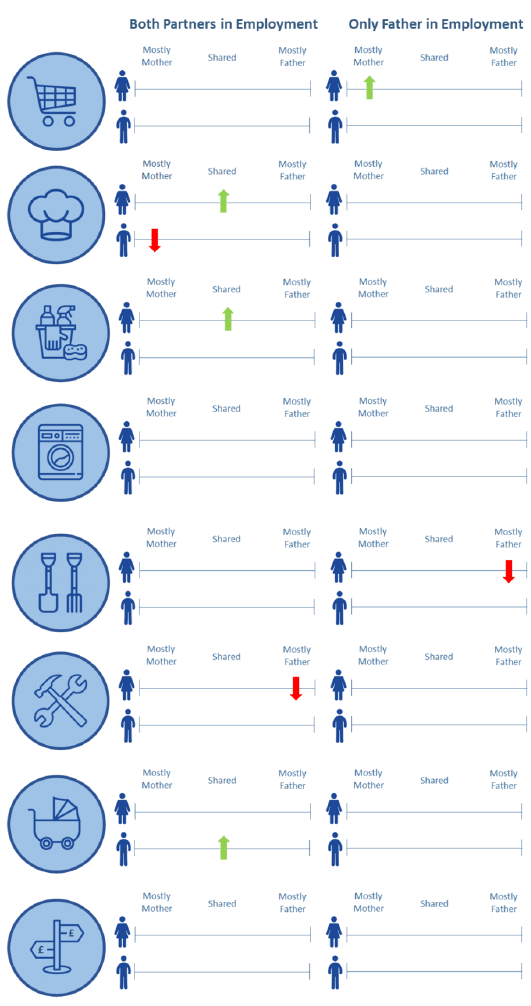
Source: Understanding Society, Waves 2, 4, 6, and 8 (2010-2012, 2012-2014, 2014-2016, and 2016-2018).
Contact
Email: Spencer.Thompson@gov.scot
There is a problem
Thanks for your feedback